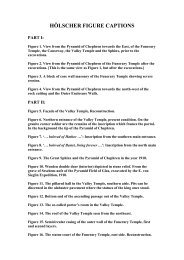download introduction as a pdf - egyptian dawn - robert temple
download introduction as a pdf - egyptian dawn - robert temple
download introduction as a pdf - egyptian dawn - robert temple
You also want an ePaper? Increase the reach of your titles
YUMPU automatically turns print PDFs into web optimized ePapers that Google loves.
2<br />
W<strong>as</strong> this now the type according to which we would have to reconstruct<br />
the funerary <strong>temple</strong>s of the Fourth Dyn<strong>as</strong>ty? Who would dare to answer this<br />
question with an unequivocal yes, considering that one did not even know yet if<br />
with the rooms so far revealed, the interior of the Gate building had been<br />
completely excavated, whether or not an open hall might still have been<br />
positioned before it, <strong>as</strong> with the Gate <strong>temple</strong>s of Abusir, and where fant<strong>as</strong>tic<br />
rumours about the building of its facade were in circulation since Mariette’s<br />
time. Should the <strong>temple</strong> itself not have been decorated with richer adornment<br />
and reliefs? After all, the private graves of the Fourth Dyn<strong>as</strong>ty very often showed<br />
relief decorations in many places. And how should we imagine the actual<br />
complex of the funerary <strong>temple</strong>s? The size of this Gate building and of the<br />
Pyramid implied immensity. Here only a thorough excavation could help. [Note:<br />
from here on, Hölscher’s name of Torbau (‘Gate Building’, or ‘Gatehouse’) for the<br />
Valley Temple will be abandoned, and in translation we shall call the structure by<br />
its current name of the Valley Temple.]<br />
A first attempt to gain clarity about the building of the Valley Temple had<br />
already been made at times by the Leipzig M<strong>as</strong>taba Excavations at Giza in 1905<br />
under Georg Steindorff. But in doing so, it had soon become evident that with<br />
the relatively restricted means available, the t<strong>as</strong>k could not be executed. The<br />
m<strong>as</strong>ses of sand which needed to be shifted were too enormous. After they had<br />
created a relatively insignificant gap in front of the southern main entrance, they<br />
had to give up the t<strong>as</strong>k for the time being.<br />
In the meantime, George Reisner had been privileged to be <strong>as</strong>ked by<br />
Harvard University to tackle the Funerary Temple at the foot of the third<br />
pyramid. And shortly after that, he found the Gatehouse [i.e., the Valley Temple<br />
of Mycerinus] belonging to it in the valley. Precious scientific results and rich<br />
findings rewarded his careful work stretching over many years. But in relation<br />
to architecture, the results left something to be desired. For the funeral<br />
monument of Mycerinus w<strong>as</strong> still completely unfinished at the early death of its<br />
constructor. Only his successor Shepseskaf finished it superficially in brick,<br />
whereby the original project w<strong>as</strong> many times changed and simplified. That is,<br />
with regard to our question <strong>as</strong> to how the funerary <strong>temple</strong>s of the Fourth<br />
Dyn<strong>as</strong>ty might have looked, the Mycerinus <strong>temple</strong> could only give us an<br />
insufficient answer.<br />
As the ruins in front of the Cheops Pyramid [Note: of this Funerary<br />
Temple of Cheops, only part of a pavement survives.] also promised very little<br />
success, 4 many questioning glances 5 were directed towards the Chephren <strong>temple</strong>,<br />
especially since, in view of the Valley Temple, one had to <strong>as</strong>sume that this<br />
complex had been totally completed. On the other hand, the appearance and the<br />
exploratory excavation of Flinders Petrie revealed that this <strong>temple</strong> also w<strong>as</strong> in a<br />
desolate condition of destruction. Certainly we suspect that into recent times,<br />
considerable parts of the <strong>temple</strong> had still stood upright, because M<strong>as</strong>pero 6 tells<br />
us that around 1700 [Benoit de] Maillet had still seen four big pillars of the<br />
<strong>temple</strong> erect. However, that w<strong>as</strong> revealed later <strong>as</strong> an error of M<strong>as</strong>pero’s, because<br />
Maillet claims 7 this not of the <strong>temple</strong> in front of the second pyramid, but of the<br />
one in front of the third pyramid, where the pillars are still standing just like<br />
that today. 8



